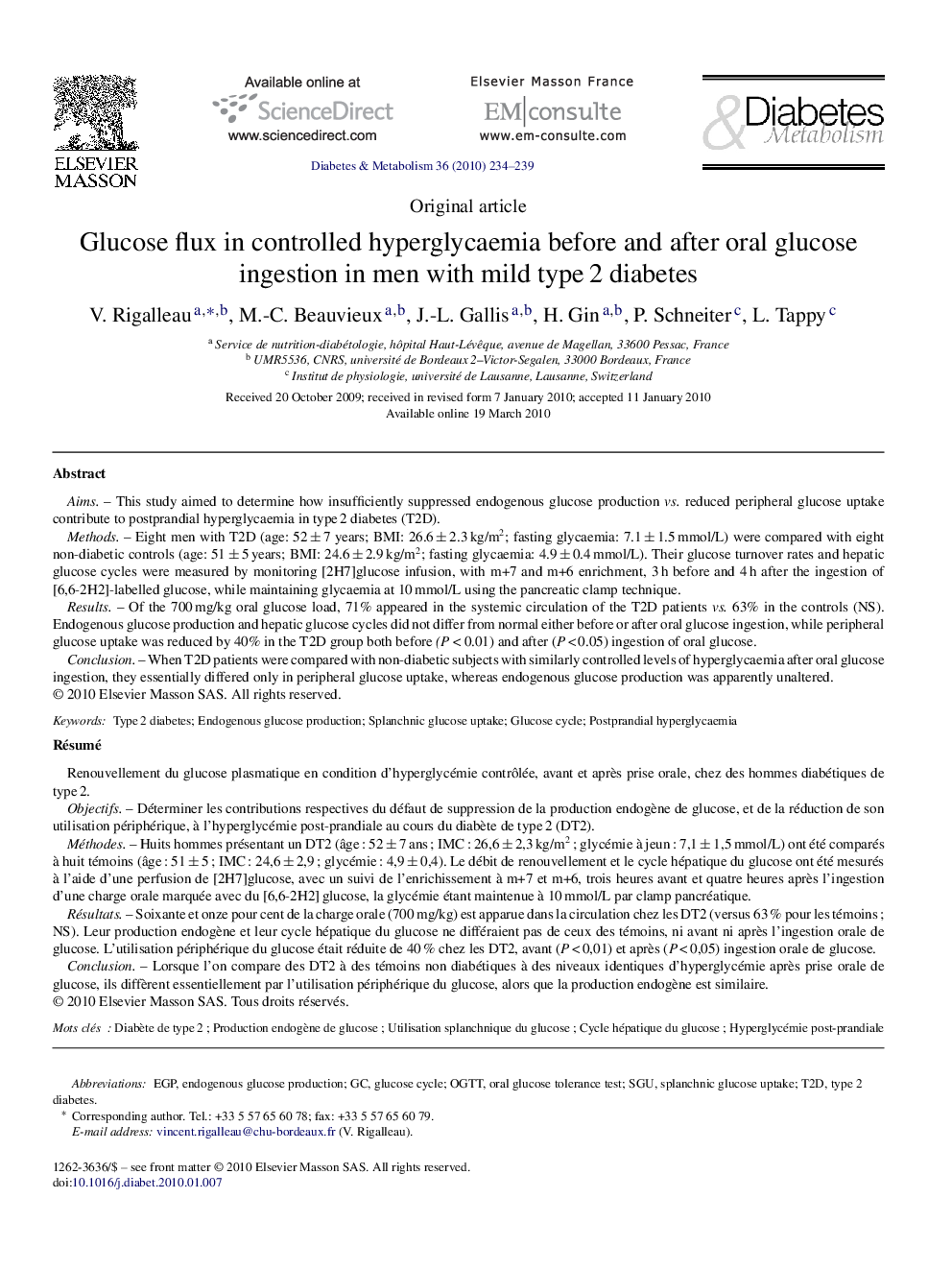| کد مقاله | کد نشریه | سال انتشار | مقاله انگلیسی | نسخه تمام متن |
|---|---|---|---|---|
| 3260368 | 1207618 | 2010 | 6 صفحه PDF | دانلود رایگان |

AimsThis study aimed to determine how insufficiently suppressed endogenous glucose production vs. reduced peripheral glucose uptake contribute to postprandial hyperglycaemia in type 2 diabetes (T2D).MethodsEight men with T2D (age: 52 ± 7 years; BMI: 26.6 ± 2.3 kg/m2; fasting glycaemia: 7.1 ± 1.5 mmol/L) were compared with eight non-diabetic controls (age: 51 ± 5 years; BMI: 24.6 ± 2.9 kg/m2; fasting glycaemia: 4.9 ± 0.4 mmol/L). Their glucose turnover rates and hepatic glucose cycles were measured by monitoring [2H7]glucose infusion, with m+7 and m+6 enrichment, 3 h before and 4 h after the ingestion of [6,6-2H2]-labelled glucose, while maintaining glycaemia at 10 mmol/L using the pancreatic clamp technique.ResultsOf the 700 mg/kg oral glucose load, 71% appeared in the systemic circulation of the T2D patients vs. 63% in the controls (NS). Endogenous glucose production and hepatic glucose cycles did not differ from normal either before or after oral glucose ingestion, while peripheral glucose uptake was reduced by 40% in the T2D group both before (P < 0.01) and after (P < 0.05) ingestion of oral glucose.ConclusionWhen T2D patients were compared with non-diabetic subjects with similarly controlled levels of hyperglycaemia after oral glucose ingestion, they essentially differed only in peripheral glucose uptake, whereas endogenous glucose production was apparently unaltered.
RésuméObjectifsDéterminer les contributions respectives du défaut de suppression de la production endogène de glucose, et de la réduction de son utilisation périphérique, à l’hyperglycémie post-prandiale au cours du diabète de type 2 (DT2).MéthodesHuits hommes présentant un DT2 (âge : 52 ± 7 ans ; IMC : 26,6 ± 2,3 kg/m2 ; glycémie à jeun : 7,1 ± 1,5 mmol/L) ont été comparés à huit témoins (âge : 51 ± 5 ; IMC : 24,6 ± 2,9 ; glycémie : 4,9 ± 0,4). Le débit de renouvellement et le cycle hépatique du glucose ont été mesurés à l’aide d’une perfusion de [2H7]glucose, avec un suivi de l’enrichissement à m+7 et m+6, trois heures avant et quatre heures après l’ingestion d’une charge orale marquée avec du [6,6-2H2] glucose, la glycémie étant maintenue à 10 mmol/L par clamp pancréatique.RésultatsSoixante et onze pour cent de la charge orale (700 mg/kg) est apparue dans la circulation chez les DT2 (versus 63 % pour les témoins ; NS). Leur production endogène et leur cycle hépatique du glucose ne différaient pas de ceux des témoins, ni avant ni après l’ingestion orale de glucose. L’utilisation périphérique du glucose était réduite de 40 % chez les DT2, avant (P < 0,01) et après (P < 0,05) ingestion orale de glucose.ConclusionLorsque l’on compare des DT2 à des témoins non diabétiques à des niveaux identiques d’hyperglycémie après prise orale de glucose, ils diffèrent essentiellement par l’utilisation périphérique du glucose, alors que la production endogène est similaire.
Journal: Diabetes & Metabolism - Volume 36, Issue 3, June 2010, Pages 234–239